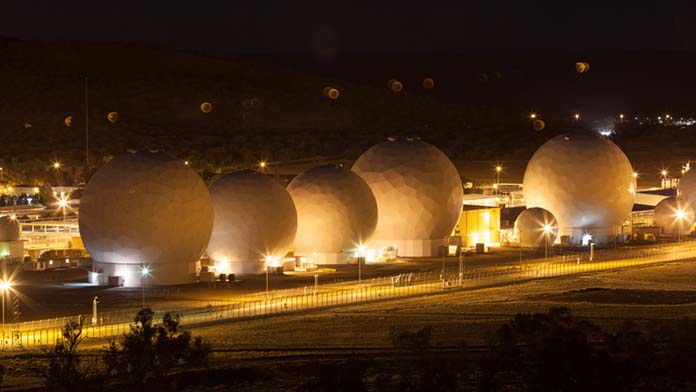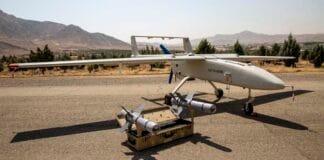The base at Pine Gap near Alice Springs plays a key role in US surveillance and military operations, as well as the Australia-US alliance, writes Feiyi Zhang
Australia’s alliance with the US has seen it send troops to almost every major US war, from Vietnam to Afghanistan and Iraq. But Australia’s most important contribution to the US war machine has not been boots on the ground, but a spy base near Alice Springs.
Pine Gap is “perhaps the most important United States intelligence facility outside that country”, according to Professor Richard Tanter.
It is not the only US intelligence base in Australia—there is also the Shoal Bay Receiving Station outside Darwin, the satellite communication facility at Geraldton and the North West Cape naval station, both in Western Australia. But Pine Gap is by far the largest and most important.
Pine Gap was first established in 1966 as a ground station for signals intelligence from early satellites. Its initial aim was to capture telemetry from Soviet missile testing during the Cold War—intercepting the radio signals used to deliver measurements during tests.
Australia offered the only suitable location capable of receiving signals and controlling satellites over an enormous area of the globe between the mid-Pacific and east Africa.
Its position at a remote inland area made it secure from observation by other countries’ intelligence services.
Today it also plays a key role in targeting US missile strikes and other military operations. Professor Des Ball said there had been “a fundamental transformation” in the role of the Pine Gap facility over the decades from “a highly specialised mission” to a “multi-agency, multi-purpose mega-intelligence centre.”
The centrepiece of the facility are its famous domes or radomes that hide most of its 33 major antenna systems. The complex employs around 800 staff, half of them Australian, but most of the intelligence operators remain Americans.
While it is officially known as a “Joint Defence Facility” between Australia and the US, it was established to serve the needs of the US and is a key hub in the US’s global surveillance network.
Today it controls two sets of military intelligence satellites, one that captures electronic transmissions from space, and the other detecting heat blooms from missile launches and aircraft via infrared.
Pine Gap produces data from both systems which is mashed up with other forms of imagery and human intelligence.
The facility sucks up huge amounts of electronic data from air, sea and ground transmission of missile tests, and from military radars, microwave transmissions, mobile phones and satellite phones.
A shroud of secrecy has always covered the operations of Pine Gap, with much of the public information about its operations only surfacing through whistle-blowers.
Documents leaked by former US intelligence officer Edward Snowden from 2013 confirmed that Pine Gap plays a key role in US military operations.
It has supported every US war since the Iraq invasion of 1991, when it intercepted and relayed information on Iraqi missile launches and military operations. It helped track Serbian military communications during the Kosovo war in 1999.
By the time of the Afghanistan invasion in 2001, it was able to send detailed intelligence and targeting information to ships, fighter jets and even to individual special operations units on the ground.
In the event of war with China, Pine Gap’s role would make it a prime target.
Its role in the detection and interception of any hostile missile launch means that it plays a key role in US and Japanese missile defence systems, designed to shield them from nuclear attack by China or Russia.
Its role in missile targeting means it would also play a key role in planning US nuclear missile strikes. Pine Gap therefore implicates Australia in operating the US system of nuclear warfare.
This creates the likelihood of Pine Gap being a target for nuclear weapons, putting surrounding Aboriginal communities and the Alice Springs township in immediate danger. The Australian Government admitted this risk in documents in 1980, which were only declassified from top secret classifications in 2012.
Drone targeting
One of its most controversial operations is Pine Gap’s role in the US program of drone assassination in countries including Pakistan, Somalia and Yemen.
Sources speaking to investigative journalist Philip Dorling in 2013 explained the role that Pine Gap played in locating targets for drone strikes in Pakistan and Afghanistan, which killed between 2500 and 3500 suspected Taliban and Al Qaeda militants.
The facility allows the US military to identify the location of individuals holding mobile phones and hand-held radios through tracking their signals.
One former Pine Gap operator told him “We track them, we combine the signals intelligence with imagery, and once we’ve passed the geolocation intell[igence] on, our job is done. When drones do their job we don’t need to track that target any more.”
The strikes have also resulted in the deaths of hundreds of civilians and are considered by human rights advocates to constitute potential war crimes and violations of international law.
Australian militarism
The fact that Pine Gap was set up by the US government, the world’s dominant imperialist power, leads many people to think that Australia is doing the bidding of the US and therefore we need a more “independent” foreign policy.
For example, commentator and former senior public servant John Menadue argues that “Our military and defence leaders are heavily dependent on the US Departments of Defence and State, the CIA and the FBI for advice. We act as their branch offices.”
In fact the Australian government’s hosting of Pine Gap is a calculated decision in the service of its own imperialist interests.
The Australian military and intelligence services benefit from their integration into the running of Pine Gap, with access to the intelligence it provides. This is part of a broader system of intelligence-sharing under the Five Eyes partnership with the UK, Canada and New Zealand.
It also views Pine Gap as a crucial asset maintaining the US Alliance. Kim Beazley, a former Labor Defence Minister and Opposition Leader, as well as a notorious war hawk, has argued that “A constant theme among Australian officials has been the critical leverage [Pine Gap] has given us in our relationship with our ally … It has deepened the value of Australia as an American partner and given us strategic weight in the relationship.”
The Australian government has its own imperialist interests and a brutal history of militarism in the Asia-Pacific.
Australia dominates the south Pacific and insists on the right to exclude other powers like China.
As Australia ramps up funding for its military to the highest levels since the Vietnam War in the 1970s, and signs up the AUKUS agreement to build nuclear-powered submarines, it is critical that we oppose the warmongering of our own Labor Government.
Australia is also increasingly important real estate for the US military as it steps up efforts to contain China’s growth as a regional power, and maintain US dominance of the Asia-Pacific.
This has seen the US move to strengthen alliances in the region with countries such as Japan, South Korea and the Philippines against China. The US has succeeded in reaching an agreement with the Philippines to resume the use of bases in the country, expanded to a total of nine facilities this year.
A US Force Posture Review in late 2021 directed the military to enhance “infrastructure in Guam and Australia”.
Visits by US submarines and US aircraft, including nuclear-capable B-52 bombers, as well as marines and other ground forces are becoming increasing frequent.
The US and Australian governments constantly present China as a military threat, pointing to its claims over Taiwan and its actions in the South China Sea. But China is effectively encircled by US bases across the Pacific, with the US attempting to maintain control over the entire Pacific Ocean.
It is the US and Australia who are creating the threat through a military build-up and provocations against China.
The US has a belt of 750 military bases circling the globe, while China has just one foreign military base, in Djibouti. The US still maintains an overall military superiority by a large margin.
Building opposition
Pine Gap and US bases in Australia have long been a target of opposition and anti-war protests.
The first major protest at Pine Gap was a gathering of 700 women in 1983. It was supported indirectly by 12 Labor MPs, reflecting a contest within the Labor Party over support for the base.
Inspired by the actions of women camped outside Greenham Common in the UK to protest against nuclear weapons and war, the Women for Survival coalition led an action of 800 Aboriginal and non-Aboriginal women protesting in the searing desert heat.
It was timed to coincide with Remembrance Day, the arrival of Pershing missiles at Greenham and the death of anti-nuclear campaigner Karen Silkwood. Other significant actions took place in 1987 and again in 2002 against the proposed war against Iraq.
Australia’s escalating militarism and the expansion of US bases here needs to be opposed every step of the way, from Pine Gap to the AUKUS nuclear submarines.
Workers in Australia have no interest in supporting the militarism and warmongering that threatens death and destruction on an appalling scale—and the risk of a nuclear exchange between the US and China.
We need to build an anti-war movement that can put a stop to this madness.






